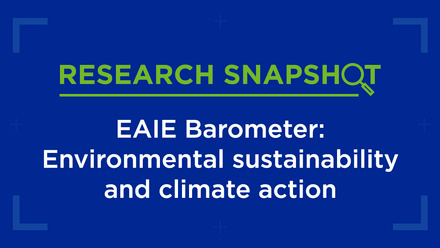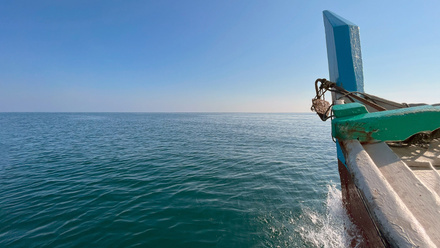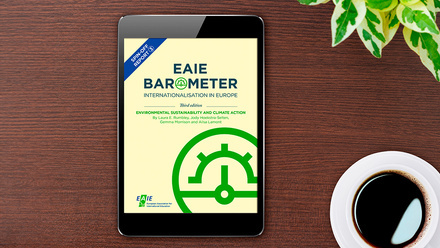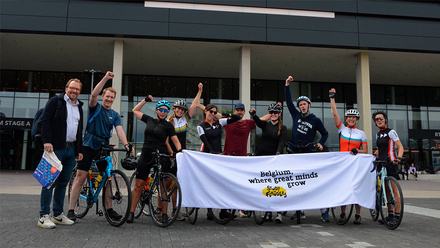Clear skies, blue seas, green trees and us

In the lead-up to the 2022 EAIE Conference and Exhibition in Barcelona, a series of Conference Conversation Starter essays are being published here on the blog to encourage us to start thinking about this year’s theme of ‘The future in full colour’. This third and final Conference Conversation Starter essay underscores the pressing nature of the global climate crisis, the actions already being taken on a number of fronts, and what role international educators can play in finding solutions.
As international educators, we are passionate about giving our students the best learning experience, one they will remember in 50 years when thinking back on their studies. Ideally, it’s an experience that will help them shape a better future. It’s an experience that will empower them as young adults in a multi-cultural environment.
Do you remember your most salient learning experience? I will never forget a simulation of climate negotiations 20 years ago that provided me a deep dive into the global dimension of climate change. This was a wake-up call to the fact that the clear skies, blue seas and green trees that we took for granted on our beautiful campus were endangered ecosystems that needed our collective attention.
A bold agenda
Today, scientists responsible for the IPCC report Climate Change 2022, Impacts, Adaptation and Vulnerability underscore the fact that climate, ecosystems, biodiversity and human societies are deeply interdependent. They call for immediate action on climate change, conservation and restoration of ecosystems: “Any further delay in concerted anticipatory global action on climate adaptation and mitigation will miss a brief and rapidly-closing window of opportunity to secure a liveable and sustainable future for all”. This means changing our energy systems, our modes of transportation, our industrial processes, our construction techniques and our agricultural practices. It’s a bold agenda that requires a departure from business as usual.
The clear skies, blue seas and green trees that we take for granted are endangered ecosystems that needed our collective attention
In 2020, the European Commission adopted an ambitious programme, the ‘Green Deal’, a €600bn roadmap to achieving carbon neutrality by 2050. Rising to this challenge will deeply influence our economy and our lifestyles. By 2021, France had already adopted a climate and resilience law by which large companies must identify the new competencies needed for this ecological transition and adjust their human resources strategies accordingly. The higher education sector is thus also deeply implicated in this agenda, with important ramifications for international education specifically.
So, if we as international educators want to create experiences that students will remember in 50 years, and will also contribute to addressing these urgent climate needs now and over the next decades, then providing students with education on environmental issues makes sense. But, how best to undertake this work?
Collective commitment and purposeful action
Operating from the premise that a sector-wide approach is vital, we need to find ways to work together purposefully and effectively. One way to do this is through organisations like the Climate Action Network for International Educators (CANIE). Launched in 2020, CANIE is striving for a carbon-neutral and climate-literate international education sector by 2030. CANIE has worked with several leaders of the international education sector to propose the CANIE Accord, a set of principles and commitments that guide organisations to reduce their carbon emissions, support advocacy, and foster climate literacy. The EAIE is one signatory of the Accord.
In addition to laying out these principles and commitments, the CANIE Accord contains guidelines on decarbonisation of operations and travel. One good example of these guidelines in action is the ‘Travel with CANIE’ initiative which links CANIE and international education associations in encouraging sustainable travel to conferences in our field. ‘Travel with CANIE’ fosters carbon emissions reductions and carbon literacy of conference participants, as well as networking among the community of sustainable travellers. The Accord also encourages advocacy for a socially just and ecological transition to carbon neutrality. Supporting youth organisations’ advocacy to empower young people and enable effective youth-to-youth communication is another important aspect of this work. The Accord also highlights the integration of environmental literacy in education programmes as a priority.
Overcoming eco-anxiety
Integrating environmental literacy in (international) education programmes is indeed critical, as the capacity to act on climate change depends on students actually gaining a solid understanding of environmental issues through their education. Of course, students are aware of the ecological crisis and the coming changes, but they don’t necessarily have the right knowledge and skills to act on this information. In France, for example, a recent survey from IPSOS and Fondation du Collège de France showed that 79% of young people are interested in climate change, but 46% don’t know what greenhouse gasses are.
The gap between eco-awareness and eco-competencies opens the door to eco-anxiety
The gap between eco-awareness and eco-competencies opens the door to eco-anxiety. ‘Eco-anxiety’ refers to a form of anxiety related to any and all aspects of the ecological crisis around us, from climate change and deforestation to species extinction and pollution. In 2021, an international survey in 10 countries revealed that 45% of young people said their feelings about climate change "negatively affected their daily life and functioning". Climate psychologists recommend knowledge and action as the best therapy for eco-anxiety. Thus, empowering students to act on environmental issues becomes critical to help them build a healthy relationship with the environment.
Designing environmental education programmes
In providing climate education to students through international education, we face what I call the ‘climate education dilemma’: we need to provide this education without depressing students with the complexity of the issues. My eight years of experience in climate education and training have shown that combining science, innovative pedagogy and experiential learning helps overcome the barriers of eco-anxiety and break down complexity.
For students who aren’t specialising in earth sciences, games such as the Climate Fresk, which maps out the causes and consequences of climate change, can be a useful tool. Focusing on solutions can also help overcome doom and gloom. The Drawdown Project is a useful pedagogical tool for educators since it presents impactful climate solutions for decarbonisation.
To be meaningful to students, solutions should relate to their field of study and be based on local examples. For example, according to Monica Perez Bedmar, Seminar Director of the Marine Ecology Seminar and Instructor at the Syracuse University Madrid programme, field studies are essential to learn about marine biodiversity. Her programme offers a course on the management of the Mediterranean coastal ecosystems including field trips to assess the impact of environmental protection measures on local marine eco-systems.
Shifting values
Education is a vital first step, but effectively addressing the climate crisis will require changing behaviours. Behaviours are largely driven by our values and beliefs. In a sense, the current environmental crisis reveals the lack of environmental values. How can we inspire behavioural change rather than imposing it? This is where the transformative potential of international education comes into play.
As international educators, we can introduce students to cultural environments with embedded environmental values
International education provides opportunities for immersion in different cultural environments, in which students can discover different sets of values and beliefs. Moreover, cultural diversity fosters creative thinking about problem solving. As international educators, we can seize these opportunities to introduce students to cultural environments with embedded environmental values. For example, many indigenous communities have preserved close relationships with nature. Matthew Aruch, Global Education Director at Earthday, studied the benefits of the Pinkaiti Partnership which takes students on field trips to the Amazon in Brazil while keeping the conservation of the Kayapo Forest as the principal objective of the project. In reflecting on the programme, Aruch notes that “Participants cited the social and emotional learning that comes from interacting with different cultures, languages, and environments.” He further highlights that the university participation – which included activities from researchers, instructors and students from universities from Brazil, Canada and the US – made a significant contribution to the forest protection as well as other important educational, social and economic outcomes. This type of multi-stakeholder partnership could be a source of inspiration for others undertaking international education programme design focused on similar objectives.
Our work matters
In the current context, there is no room for ‘business as usual’. We as international educators have the opportunity to influence the transition to carbon neutrality through the design of life-changing educational experiences that will reduce carbon emissions and protect and restore ecosystems. To ensure clear skies, blue seas and green trees, international educators worldwide must band together in committing to a bold agenda and designing education programmes that instil the values we need to meet the challenge of our changing climate.
Questions for discussion
- Is your organisation interested in signing the CANIE Accord?
- How does your organisation integrate environmental issues in programme design?
- How does your organisation take into consideration eco-anxiety and solutions to eco-anxiety in its operations and programmes?
- What multi-stakeholder partnerships can your organisation build to foster carbon emissions reduction, conservation of biodiversity and ecosystem restoration?






